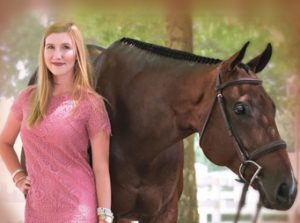Leap of Faith – Katelyn Schultz Jumps with No Depth Perception
Click here to read the complete article60 – January/February 2019
BY KRISTEN SPINNING
PHOTO ©RUEHLE PHOTOGRAPHIX
 Katelyn Schultz had an exceptional year with her 11-year-old gelding, Dance Somemore (aka Connor). She says her goal for the AQHA Youth World was simply to have solid rounds and have fun. She says, “My biggest thing before every single ride and every single course that I jumped was that I wanted to go in and enjoy my horse. When I went in with that mindset, it obviously worked pretty well for me!”
Katelyn Schultz had an exceptional year with her 11-year-old gelding, Dance Somemore (aka Connor). She says her goal for the AQHA Youth World was simply to have solid rounds and have fun. She says, “My biggest thing before every single ride and every single course that I jumped was that I wanted to go in and enjoy my horse. When I went in with that mindset, it obviously worked pretty well for me!”
That’s an understatement. Katelyn won World Championships in Level 2 Equitation Over Fences, Level 2 Hunter Hack, Level 2 Equitation On The Flat, and Level 2 Hunter Under Saddle. She made the finals in every class she entered amidst tremendously deep competition. “I’ve never had a Youth World Show like that,” she marvels. She cherishes every bit of the experience, from the extreme highs of receiving numerous golden trophies to the little bumps and bobbles along the way. She’s riding that momentum into the Quarter Horse Congress, which will be the final show of her AQHA youth career.
Katelyn’s collection of trophies is impressive. The fact that she was born without any depth perception makes her riding acumen even more remarkable. The visual ability most of us take for granted is achieved when the brain processes slightly different images from each eye and combines them to form a single 3-D image. Depth perception makes it possible for us to determine the distance between objects and to tell if something is near to us or far away. Katelyn describes a scenario to explain the way she visually experiences the world. “If you’re looking at a Showmanship pattern, and the cones are set in a zig zag, you can see that one is in front, the next one is further away, and the next one is further still. When I look at them, they appear to be in a straight line. It’s difficult for me to determine what’s further and what’s closer,” she says. She also describes it as though everything around her is painted flat, like a picture, rather than objects that have obvious separations.
Katelyn has adapted to rely on other visual cues in her environment to gauge depth; however, that method is inherently less accurate when judging critical distance. It’s a deficit that affects nearly every part of her life. For instance, one common struggle is navigating escalators, because she has to judge the depth into the steps as well as the fact that they’re moving. She cheerfully quips that since she never had depth perception, she simply learned to be fine without it. She certainly did fine in Oklahoma City without it.
Click here to read the complete article60 – January/February 2019










